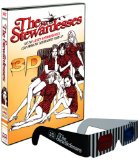So there’s this group of flight attendants, and we follow their swinging adventures and affairs on and off planes. One, for instance, hopes to be an actress, and hooks up with an advertising executive. And if you care what the plot of “the first 3D sex film” is, you need your head examined. Much of the what goes on is mind-numbingly banal (SEE Wine being poured SEE Drinks being mixed HEAR Dull conversations ), though the acid trip that leads one woman to make out with a lamp in the form of a greco-roman head is something you don’t see every day.
The film is an object lesson on how far mere novelty can take a film – it was a huge success at the time, and 3D was, in 1969, a rarity again after its initial craze in the 50s. So there are numerous shots of legs and pool cues (and feet) jabbing at the camera, enough, presumably, to have kept audiences entertained while everything else remained mundane beyond words. Or, so the situation is for most of the running time. But the last act takes a sudden turn into the starkly dramatic, and becomes very dark indeed. It is also rather more imaginatively shot than most of the rest of the film. The ending is a vicious sucker punch that must be seen to be believed, and suggests that the filmmakers were storing all of their creative juices for the cruel finale. In fact, as the accompanying featurettes reveal, the dramatic plot was added to the film after the rest of it was completed, and indeed, after it had already been released in some markets. In the final analysis, this is a vital piece of low culture.
Audio
The mono is nice. It’s crisp, and there’s very little hiss and static given how cheap the original feature is. It isn’t perfect, but it’s unimaginable that the original track ever was. So the fact that the music sounds fine, that the dialogue is clear, and that nothing egregious assaults the ear is actually fairly impressive. The overall tone is quite warm, too.
Video
This is not the place to expect miracles. 3D is still not a process that is entirely happy on television, and things are no different here. Both colour and black-and-white versions of the film are on the disc, and both liner notes and menu suggest the latter is the way to go for the best stereoscopic effect. This is true. The B&W is somewhat clearer, with a stronger sense of depth, and is less headache-inducing, but it’s still a bit hard on the eyes, with a smearing of red, a slight doubling of image, and aliasing that is only visible when you watch with both eyes open. The colours are decent, in that they’re clearly true to the original, but hardly glorious to start with. They are, however, enormously improved over how most audiences would have seen the film (scope out the restoration comparison included in one of the documentaries on Disc 2). There is some speckling and grain going on, but all in all the print is in as good a shape as one could hope for. For those whose eyes begin to bleed, a 2D version of the film is also provided.
Special Features
Disc 1 (with the 3D versions of the film) offers up the original title sequence, deleted scenes, and 3D lens tests. All of this footage is minus audio, for reasons that become clear on Disc 2, where we learn how the film was made. So on Disc 2 is a short history of 3D films, a piece on how The Stewardesses’ process worked, and “How The Stewardesses Took Off!” This last consists of interviews with cast and crew, and is an excellent look at the making and reception of the film. To top things off, there’s the theatrical trailer and the SCTV sketch “Dr. Tongue’s House of Stewardesses.”
Final Thoughts
The film is a landmark piece of exploitation, and this package is a textbook case on how to present such features. The features are the sort that one wishes accompanied all such bits of historic sleaze.





